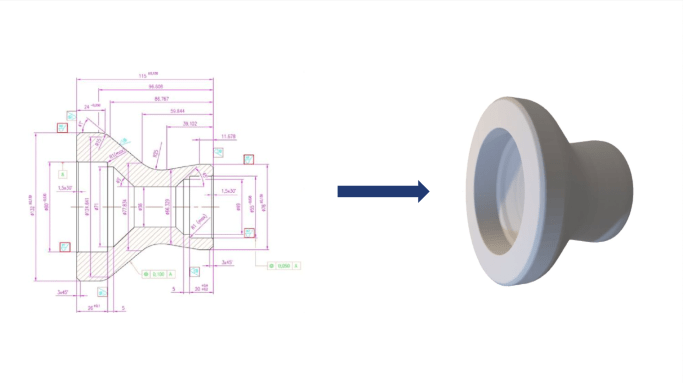The French Defense Innovation Agency, along with Spare Parts 3D and the University for Research in Automated Production (LURPA) at the École Normale Supérieure (ENS) Paris-Sarclay, have announced that they’ve begun a joint R&D project. The three-year project is named “RAPID”, not to be confused with North America’s largest 3D printing event. The goal of RAPID will be to use Spare Parts’ proprietary DigiPART platform to create a software solution capable of automated reconstruction of 2D drawings, combined with brief written product descriptions, into printable 3D models.
In a press release, the deputy director of LURPA, Nabil Anwer, explained, “The reconstruction of 3D models from technical drawings is a real challenge for which the combination of digital geometry processing techniques, expert and deep learning algorithms will pave the way for considerable breakthrough in the creation of digital inventories.” Christophe Migliorini, Spare Parts 3D’s chief technology officer (CTO), noted, “Thanks to this program, we have set up a team at the forefront of technology for the development of this fundamental software module. This will strengthen the attractiveness of our DigiPART solution and consolidate our leadership in the identification of parts for additive manufacturing.”
 Image courtesy of Spare Parts 3D
Image courtesy of Spare Parts 3D
Based in Singapore with offices in Paris, Spare Parts 3D was founded in 2015. The company’s aforementioned in-house software, DigiPART, employs algorithms to combine semantic recognition and the reading of 2D plans, with material databases and AM techniques, in order to help customers create the most economical and effective digital supply chains. On the user-end, DigiPART has three main components: IDENTIFY, CATALOG, and PRINT. As the labels suggest, “IDENTIFY” assesses the potential for 3D-printing customers’ parts, “CATALOG” creates a digital inventory for those parts, and “PRINT” connects customers with the best matches for local 3D-printing services.

The French Defense Innovation Agency was created in 2018, became operational in 2019, and has an expected 2022 budget of €1 billion (currently about $1.079 billion). The agency considers itself something of a “French DARPA” — referring of course to the U.S. military’s Defense Advanced Research Projects Agency — and was created after the EU scuttled French President Macron’s pet project of creating a European DARPA. It is headed by Emmanuel Chiva, a specialist in AI and military simulation.
LURPA, founded at ENS Paris-Sarclay in 1981, has two main divisions, both of which do work highly relevant to the RAPID project. The Geo3D team researches “the three-dimensional geometry of parts and mechanisms”, while the Automated Systems Engineering team studies Discrete Event Dynamics Systems (DEDS). DEDS modeling and simulation is increasingly important to the field of industrial engineering — among other reasons, because it’s crucial to the development and optimization of workflow management software platforms.
Various software tools that transform 2D drawings into printable 3D models have existed for some time. For instance, ZVerse, one of the most well-known company in this space, launched an earlier version of its LAYR software in 2015. In recent years, the evolution of these tools, as with the industry as a whole, has been towards greater automation, as discussed in the “Automation, Additive Manufacturing and the Factory of the Future” report from SmarTech Analysis. Like the 3D-printing sector overall, this type of software has improved in recent years. A project like this could be coming along at exactly the right time to push the tech even further. Finally, it also shows how serious all the world’s militaries — and not just those of the U.S. and China — are about taking control of their nations’ critical emerging technologies (CETs).
Subscribe to Our Email Newsletter
Stay up-to-date on all the latest news from the 3D printing industry and receive information and offers from third party vendors.
Print Services
Upload your 3D Models and get them printed quickly and efficiently.
You May Also Like
The Hospital Factory: Mayo Clinic’s In-House 3D Printing for the OR
“At Mayo Clinic, 3D printing isn’t a side project, it’s a patient-specific service that runs on hospital time, helping surgeons plan and act with confidence,” says Dr. Jonathan Morris, a...
3MF Becomes ISO Standard
The 3MF file format has become an ISO Standard, becoming part of ISO/IEC 25422:2025. The file format is still open source, and it is hoped that this move will build...
Children’s Nebraska Joins Insight Surgery to Bring 3D Printing to the OR
Children’s Nebraska is teaming up with UK-based Insight Surgery to bring personalized surgical planning and device manufacturing in-house. This move could reshape how the hospital prepares for complex procedures. By...
ASTM International Launching New Manufacturer Certification Program for 3D Printing Industry
Eight years ago, standards organization ASTM International announced that it was looking for partners to help set up a center of excellence (CoE) in the additive manufacturing field. The resulting Additive Manufacturing...































